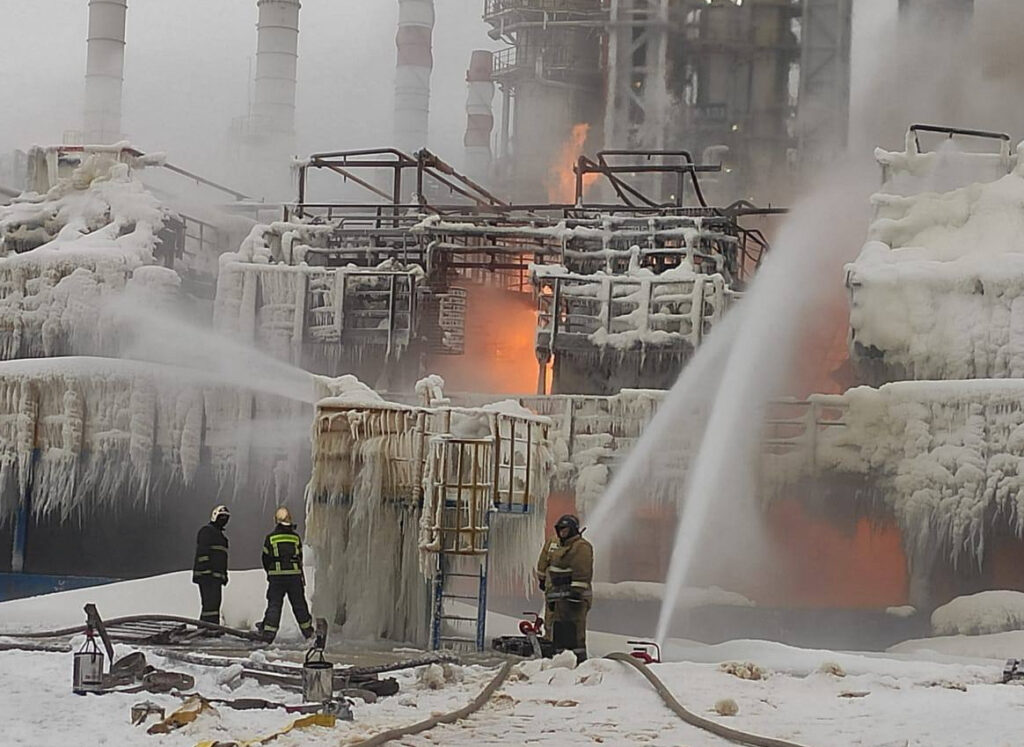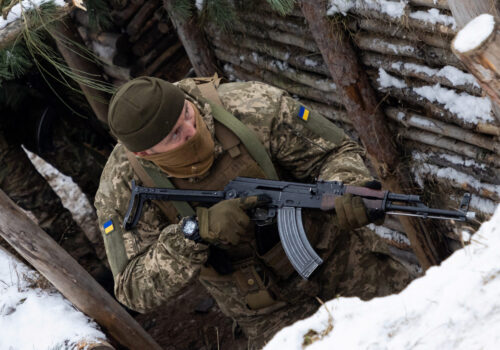Amid worsening ammunition shortages and mounting concerns over the future of Western military aid, the Ukrainian army has largely switched to active defense in recent months. Nevertheless, as the full-scale Russian invasion of Ukraine approaches the two-year mark, talk of a stalemate remains premature.
While heavy fighting continues at various hot spots along the front lines in southern and eastern Ukraine, Ukrainian commanders have begun 2024 by attempting to bring the war home to Russia with a new air strike campaign against the Russian oil and gas industry. By targeting Putin’s economically important energy sector, Ukraine hopes to weaken Russia’s war machine and create a range of dilemmas for the Kremlin.
The recent long-range Ukrainian drone strikes against energy sector targets deep inside Russia are not entirely unprecedented. Indeed, during 2023, Ukraine managed to carry out a number of successful strikes against Russian military targets.
But unlike these earlier attacks, the major feature of Ukraine’s latest drone strike campaign is the emphasis on Russia’s oil and gas processing, storage, and export facilities. Since the start of 2024, Ukraine has bombed a series of facilities located hundreds of kilometers from the border, with targets ranging from Volgograd in the south to Saint Petersburg and the Baltic Sea in the north.
These Ukrainian attacks strike at the heart of the economic engine that fuels Putin’s war machine. Oil and gas exports remain a major source of Russian GDP and have so far proved surprisingly resistant to Western sanctions, with new clients emerging to compensate for the loss of European customers. As many commentators have quipped in Kyiv, Ukraine has now decided to impose its own informal and far more direct sanctions on Russia’s energy sector.
Stay updated
As the world watches the Russian invasion of Ukraine unfold, UkraineAlert delivers the best Atlantic Council expert insight and analysis on Ukraine twice a week directly to your inbox.
Ukrainian commanders believe their new long-range drone strike campaign can eventually create major disruption to the Russian economy that will translate into leverage over the Kremlin. For now, however, the scale of the drone strikes remains limited.
One key obstacle is the size of Ukraine’s delivery systems. While Ukraine is constantly upgrading its drone fleet, the country’s existing long-range UAVs are unable to carry warheads weighing more than around 50 kilograms. This means most of the damage done at Russian energy facilities is relatively easy to localize and neutralize. Ukraine also faces significant challenges navigating past Russia’s traditional air defenses and electronic warfare systems.
Despite these limitations, there are already signs that Ukraine’s long-range air strike campaign is having an impact. A February 5 report by Bloomberg indicated Russia’s weekly oil-processing rates had dropped to the lowest level in almost two months after two major refineries were forced to halt operations following Ukrainian drone strikes.
Eurasia Center events

Ukraine’s military planners are now hoping long-range drone strikes can force their Russian counterparts to make some difficult decisions. At present, the vast majority of Russia’s air defense assets are concentrated along the front lines of the war. These systems play a crucial role providing protection against the Ukrainian Air Force and Ukraine’s increasingly deadly drone forces. As Ukraine intensifies attacks on Russia’s energy sector, Kremlin chiefs will have to choose whether to keep their country’s limited air defense systems close to the battlefield in Ukraine or redistribute them to protect oil and gas facilities inside Russia itself.
Both scenarios could potentially lead to major risks. If Russia fails to protect critical oil and gas infrastructure, there is always a danger that the sheer quantity of Ukrainian attacks may cause serious harm to the Russian economy and compromise the Kremlin’s ability to wage war. At the same time, attempts to reinforce the defense of Russian energy facilities would leave Putin’s army in Ukraine exposed and vulnerable.
Moscow faces additional dilemmas due to Russia’s vast size, which makes it extremely challenging to provide comprehensive air defense coverage. Russian officials have recently indicated that the country lacks sufficient air defense systems to fully protect major cities like Saint Petersburg against Ukraine’s expanding long-range drone threat.
The situation is further complicated by the Russian energy industry’s reliance on Western technologies. While Ukraine is currently unable to inflict major harm due to the country’s relatively modest air strike capabilities, sanctions restrictions will likely make it difficult for Russia to replace any Western equipment damaged or destroyed by Ukrainian drones.
At present, Ukraine’s new long-range drone strike campaign is too limited in scope to derail the Russian war effort of seriously disrupt the Russian economy. However, these attacks are clearly capable of inflicting economic pain, while also increasing the pressure on Russian commanders to reduce air defense protection for their army in Ukraine. This is the same dilemma Ukrainian army chiefs have faced for much of the past two years in response to Russia’s own air strikes far beyond the front lines against civilian targets including essential infrastructure.
By attacking Russia’s energy sector, Ukrainian commanders are seeking to open a new front in the war and reshape the battlefield in Ukraine itself. The recent flurry of air strikes on Putin’s oil and gas industry underlines Ukraine’s commitment to bring the war home to Russia, even while adopting a strategy of active defense along the front lines of eastern and southern Ukraine.
Mykola Bielieskov is a research fellow at the National Institute for Strategic Studies and a senior analyst at Ukrainian NGO “Come Back Alive.” The views expressed in this article are the author’s personal position and do not reflect the opinions or views of NISS or Come Back Alive.
Further reading
The views expressed in UkraineAlert are solely those of the authors and do not necessarily reflect the views of the Atlantic Council, its staff, or its supporters.

The Eurasia Center’s mission is to enhance transatlantic cooperation in promoting stability, democratic values and prosperity in Eurasia, from Eastern Europe and Turkey in the West to the Caucasus, Russia and Central Asia in the East.
Follow us on social media
and support our work
Image: Firefighters work to extinguish fire at a terminal belonging to Novatek, Russia's largest liquefied natural gas producer, in the port of Ust-Luga, Russia, January 21, 2024. Head of Administration of Kingiseppsky District of Leningrad Region (Yuri Zapalatsky Telegram channel via REUTERS)





